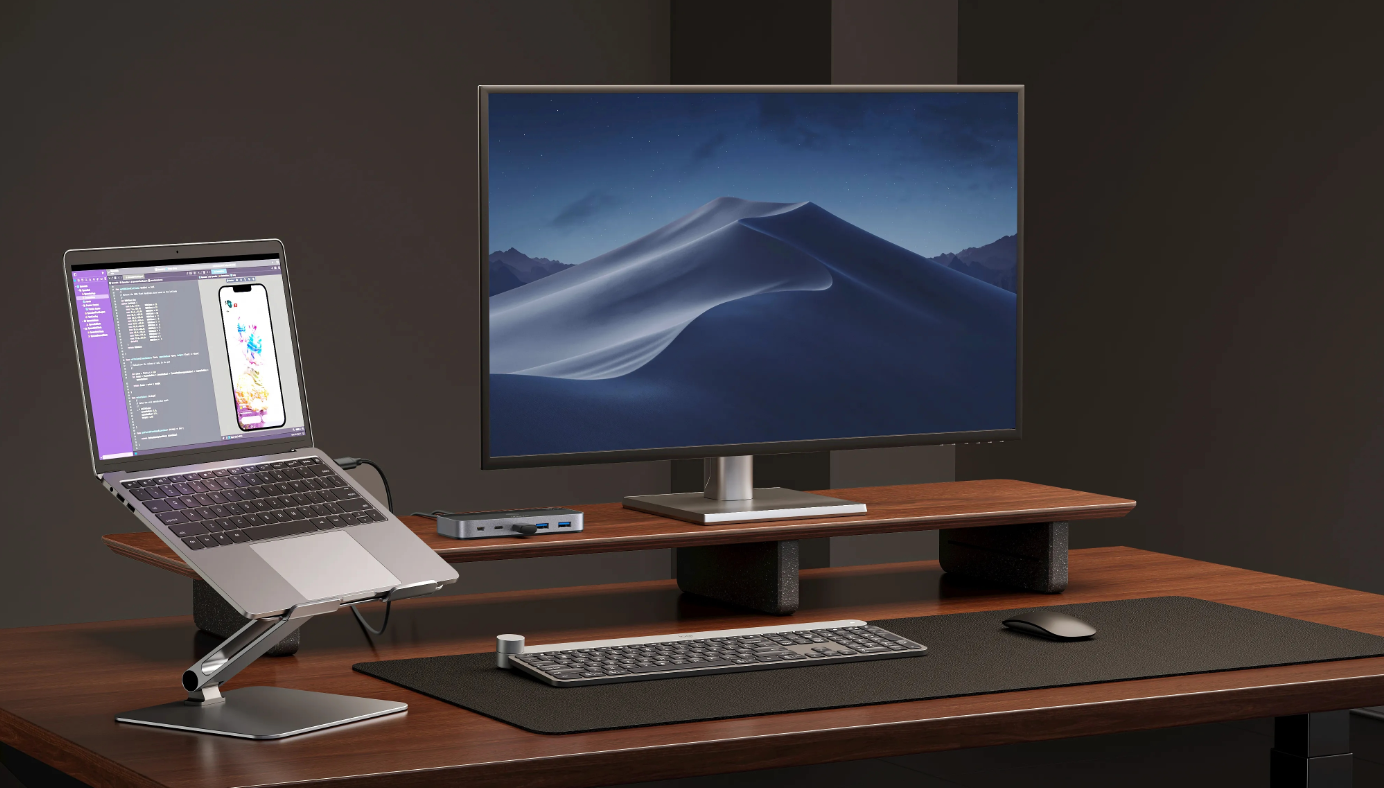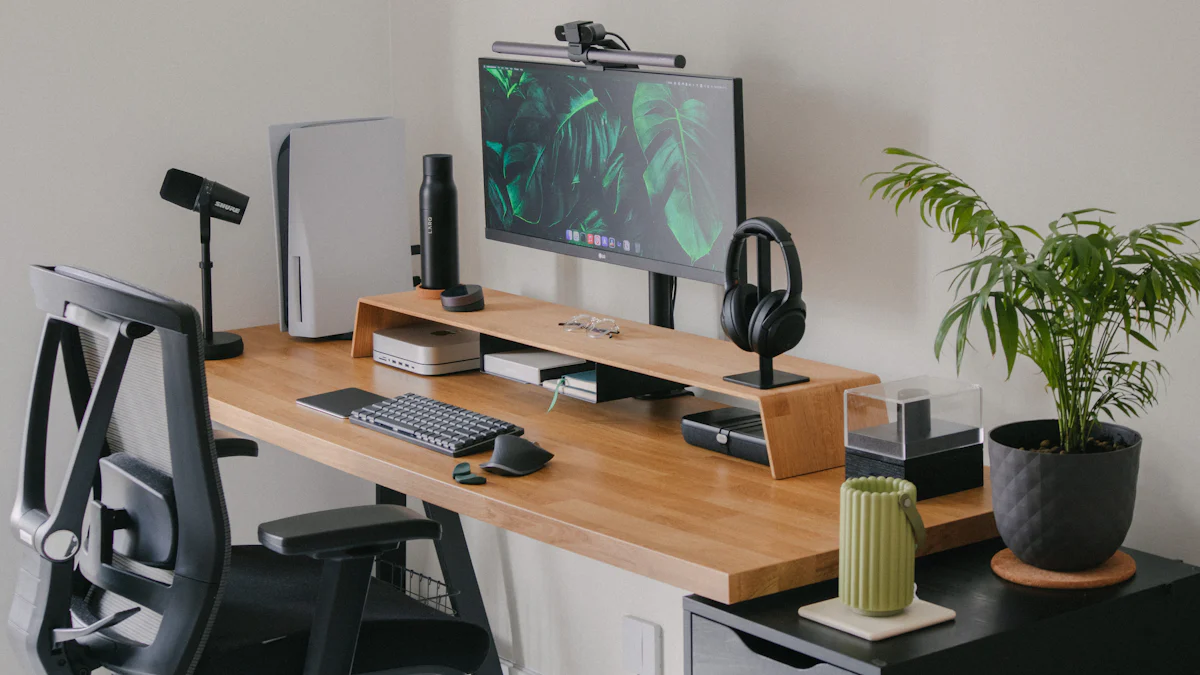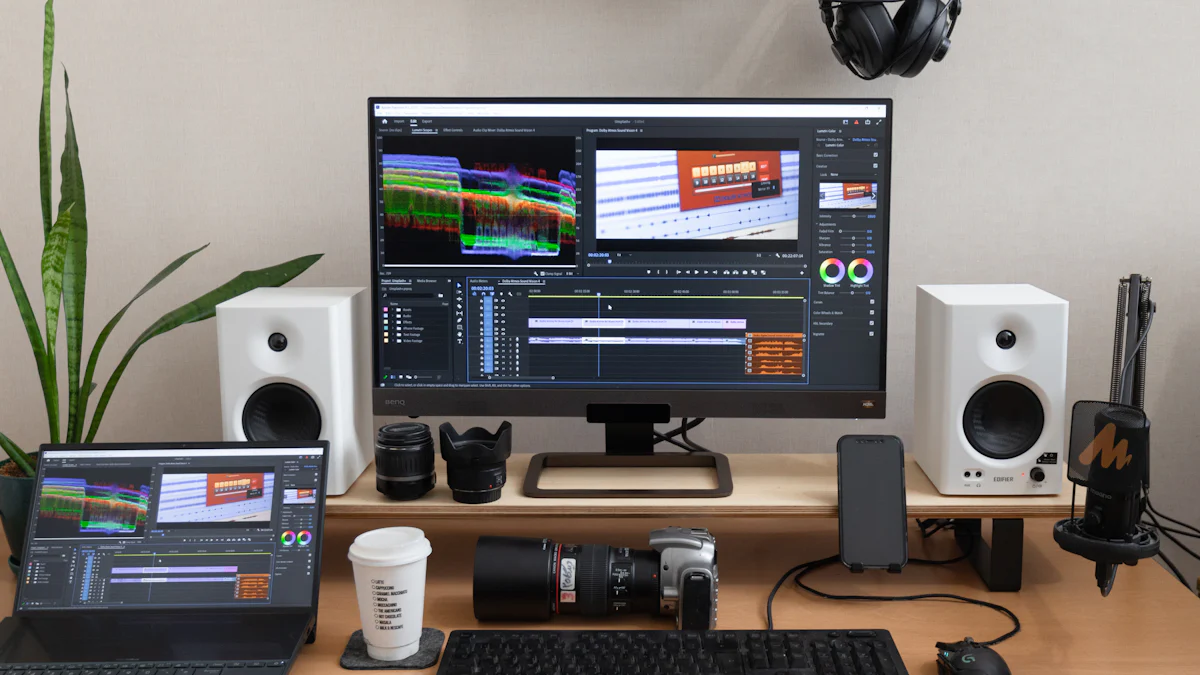
Your workspace setup matters more than you think. A good monitor stand can transform how you work. It helps you maintain better posture, reduces neck strain, and keeps your desk tidy. Whether you’re working or gaming, monitor stands are a simple way to boost comfort and productivity. Ready to upgrade your setup?
Key Takeaways
- ● Prioritize ergonomics by ensuring your monitor is at eye level to reduce neck strain and improve posture.
- ● Check for adjustability features like height, tilt, swivel, and rotation to enhance comfort and visibility while working.
- ● Consider the build quality and materials of the monitor stand to ensure durability and stability, especially for heavier monitors.
Focus on Ergonomics

Ensure Proper Eye Level
Have you ever noticed how your neck feels sore after a long day at your desk? That’s often because your monitor isn’t at the right height. To avoid this, make sure your monitor is at eye level. When you sit up straight, your eyes should align with the top third of your screen. This position reduces strain on your neck and shoulders.
A good monitor stand can help you achieve this. Many stands are adjustable, so you can raise or lower your screen to the perfect height. If you’re using multiple monitors, ensure they’re all at the same level. This keeps your head from constantly tilting up or down.
Tip: Sit at your desk and look straight ahead. If you’re looking above or below your screen, it’s time to adjust your setup.
Check Height and Tilt Adjustability
Not all monitor stands are created equal. Some offer basic height adjustments, while others let you tilt, swivel, or even rotate your screen. These features are especially useful if you switch between tasks like writing and video editing.
Height adjustability is key for comfort. You should be able to position your monitor so it feels natural to look at, whether you’re sitting or standing. Tilt adjustability is another game-changer. It allows you to angle your screen to reduce glare and improve visibility.
When shopping for monitor stands, look for models with these features. They’ll give you more control over your workspace and help you stay comfortable throughout the day.
Verify Monitor Compatibility
Measure Monitor Dimensions and Weight
Before buying a monitor stand, you need to know your monitor’s size and weight. This step ensures the stand can safely support your screen. Grab a tape measure and check the width, height, and depth of your monitor. Don’t forget to weigh it too! Most monitor stands list their maximum weight capacity, so compare it with your monitor’s weight to avoid any accidents.
If you’re using a curved or ultra-wide monitor, pay extra attention to its dimensions. These screens often need larger or more specialized stands. A stand that’s too small or weak could wobble or even tip over.
Tip: Check your monitor’s user manual or manufacturer’s website for its exact weight and size. This saves you time and ensures accuracy.
Confirm VESA Mount Standards
Have you heard of VESA? It stands for Video Electronics Standards Association, and it’s a universal standard for mounting monitors. Most modern monitors follow this standard, but it’s always good to double-check. Look at the back of your monitor for four screw holes arranged in a square or rectangle. These holes indicate VESA compatibility.
Next, match the VESA pattern on your monitor with the one supported by the stand. Common patterns include 75x75mm and 100x100mm. If your monitor doesn’t have VESA mounting holes, you’ll need a stand designed for non-VESA monitors.
Note: Not all monitor stands support every VESA pattern. Always verify this detail before making a purchase.
By measuring your monitor and confirming its VESA compatibility, you’ll avoid the hassle of returns and ensure a perfect fit for your workspace.
Explore Adjustability Options
Look for Swivel and Rotation Features
Do you ever find yourself adjusting your monitor to get the perfect angle? Swivel and rotation features can make this much easier. A monitor stand with these options lets you move your screen side to side or even rotate it vertically. This is especially helpful if you work on tasks like coding, graphic design, or reading long documents.
Swivel features allow you to share your screen with others without moving the entire stand. Rotation, on the other hand, is great for switching between landscape and portrait modes. If you’re someone who likes flexibility, these features are a must-have.
When shopping, check how smoothly the stand swivels or rotates. Some stands feel stiff, while others glide effortlessly. A smooth mechanism makes adjustments quick and hassle-free.
Tip: Test the swivel and rotation features in-store if possible. This gives you a better idea of how they’ll work in your setup.
Consider Multi-Monitor Support
Do you use more than one monitor? If so, you’ll need a stand that supports multiple screens. Multi-monitor stands keep your screens aligned and save desk space. They’re perfect for gamers, designers, or anyone who juggles multiple tasks.
Look for stands that let you adjust each monitor individually. This ensures every screen is at the right height and angle. Some stands even allow stacking monitors vertically, which can be a game-changer for tight spaces.
Before buying, check the weight capacity and size limits for each arm. This ensures the stand can handle your monitors without wobbling. A sturdy multi-monitor stand can make your workspace feel more organized and professional.
Note: If you’re unsure about compatibility, look for stands specifically designed for dual or triple monitors.
Assess Build Quality
Choose Durable Materials
When picking a monitor stand, you want something that lasts. Materials like steel, aluminum, or high-quality wood are your best bet. These materials not only look great but also hold up well over time. Plastic stands might seem like a cheaper option, but they often lack the strength and durability you need for heavier monitors.
Think about how much weight your stand will support. If you’re using a larger screen or multiple monitors, you’ll need a stand made from sturdy materials. A flimsy stand can bend or break, leaving your monitor at risk.
Tip: Check the product description or reviews to see what materials the stand is made of. If it feels solid and well-built, it’s probably a good choice.
Ensure Stability and Longevity
Stability is just as important as durability. A wobbly monitor stand can be distracting and even dangerous. Look for stands with wide bases or secure clamp systems. These features help keep your monitor steady, even if you bump your desk.
Longevity matters too. You don’t want to replace your stand every year. Choose a model with a strong build and reliable design. Some stands even come with warranties, which is a good sign of quality.
Note: Test the stand’s stability if you can. A stable stand gives you peace of mind and keeps your workspace safe.
By focusing on build quality, you’ll find a monitor stand that’s both reliable and long-lasting.
Optimize Desk Space

Select a Compact Design
Does your desk feel crowded? A bulky monitor stand might be the culprit. Choosing a compact design can free up valuable space and make your workspace feel more open. Look for stands with a slim profile or ones that elevate your monitor without taking up too much room.
If you’re working with a small desk, every inch matters. A compact stand can give you extra space for essentials like notebooks, a keyboard, or even a cup of coffee. Some stands even come with built-in storage, like drawers or shelves, to help you stay organized.
Tip: Measure your desk before buying a stand. This ensures the stand fits comfortably without overwhelming your workspace.
Compact designs don’t just save space—they also look sleek and modern. They’re perfect if you want a clean, minimalist setup.
Evaluate Base or Clamp Systems
How your monitor stand attaches to your desk can make a big difference. Stands with a base sit directly on your desk. They’re easy to set up and move around, but they can take up more space.
Clamp systems, on the other hand, attach to the edge of your desk. They save space by keeping the stand off your desk surface. Clamps are great for smaller desks or if you want a more permanent setup.
Note: Check your desk’s thickness before choosing a clamp system. Some clamps only work with certain desk sizes.
Both options have their pros and cons. If you like flexibility, go for a stand with a base. If you want to maximize desk space, clamps are the way to go.
Pro Tip: Test the stability of the base or clamp before committing. A wobbly stand can ruin your workflow.
Prioritize Cable Management
Look for Built-In Organizers
Messy cables can turn even the most beautiful workspace into a chaotic eyesore. That’s why you should look for a monitor stand with built-in cable management features. These organizers help you route and hide your cables, keeping them neat and out of sight.
Some stands come with clips, channels, or even hollow arms where you can tuck your wires. These features make it easy to keep your desk looking clean and professional. If you’re dealing with multiple monitors or devices, built-in organizers are a lifesaver. They prevent cables from tangling and make it easier to swap out equipment when needed.
Tip: Check the product photos or descriptions for cable management features. A stand with built-in organizers saves you time and effort compared to managing cables manually.
Maintain a Clutter-Free Workspace
A clutter-free desk isn’t just about aesthetics—it also boosts your focus and productivity. When cables are scattered everywhere, they can distract you and even get in the way of your work. A good monitor stand helps you keep everything in order.
Start by grouping your cables together using zip ties or Velcro straps. Then, use the stand’s cable management system to guide them along a single path. This keeps your workspace tidy and makes cleaning easier.
Pro Tip: Label your cables at both ends. This small step saves you from guessing which wire belongs to which device when you need to unplug something.
By prioritizing cable management, you’ll create a workspace that’s not only functional but also visually appealing. A clean desk equals a clear mind!
Match Your Workspace Aesthetic
Choose a Complementary Design
Your monitor stand doesn’t just hold your screen—it’s part of your workspace’s overall look. Choosing a design that complements your setup can make your desk feel more cohesive and inviting. Think about the style of your workspace. Is it modern and sleek? Or maybe it leans toward a rustic or industrial vibe?
For a minimalist setup, go for a stand with clean lines and a simple design. If your workspace has a more traditional feel, a wooden stand might blend in beautifully. Gamers often prefer stands with bold, futuristic designs that match their gear.
Tip: Take a quick look at your desk accessories. Matching the stand’s color or style to these items can tie everything together.
Don’t forget about size. A bulky stand can overwhelm a small desk, while a tiny stand might look out of place on a large workstation. Choose something that fits your space without dominating it.
Consider Material and Finish
The material and finish of your monitor stand can make a big difference in how it looks and feels. Metal stands, like aluminum or steel, often have a sleek, modern appearance. They’re perfect for contemporary setups. Wooden stands, on the other hand, add warmth and a natural touch to your desk.
Pay attention to the finish as well. Matte finishes tend to look clean and professional, while glossy ones can add a touch of luxury. If you want something unique, look for stands with textured finishes or custom designs.
Pro Tip: Choose a material that matches your desk. A wooden stand on a wooden desk creates a seamless, polished look.
By picking the right design and material, you’ll create a workspace that’s not only functional but also visually stunning.
Consider Portability and Installation
Opt for Lightweight Options
Do you move your monitor stand often? If so, a lightweight option might be your best bet. A portable stand makes it easy to rearrange your workspace or take your setup on the go. Whether you’re switching desks or working in different locations, a lighter stand saves you the hassle of heavy lifting.
Look for stands made from materials like aluminum or high-quality plastic. These materials keep the weight down without sacrificing durability. Some stands even fold flat, making them perfect for travel or storage.
Tip: Check the product weight in the description before buying. A stand that’s too heavy can be a pain to move, especially if you work in a shared or flexible workspace.
Lightweight doesn’t mean flimsy. Many portable stands are designed to hold heavy monitors securely. Just make sure the stand you choose balances portability with stability.
Ensure Easy Assembly
Nobody wants to spend hours setting up a monitor stand. That’s why you should choose one that’s easy to assemble. Look for stands with clear instructions and minimal parts. Some even come pre-assembled, so you can start using them right out of the box.
Quick assembly is especially important if you’re not a fan of tools. Many stands use simple mechanisms like screws or clamps that don’t require special equipment.
Pro Tip: Read user reviews to see how easy the stand is to put together. If multiple people mention a smooth setup process, you’re likely in good hands.
An easy-to-assemble stand saves you time and frustration. It also makes it easier to adjust or reassemble if you ever need to change your setup.
Set a Realistic Budget
Balance Features with Cost
When shopping for a monitor stand, it’s easy to get carried away by fancy features. But before you splurge, think about what you actually need. Do you really need a stand with every bell and whistle, or will a simpler model do the job?
Start by listing the features that matter most to you. Maybe you want height adjustability, cable management, or multi-monitor support. Once you know your priorities, compare models that offer those features. This helps you avoid paying extra for things you won’t use.
Tip: Don’t assume the most expensive stand is the best. Sometimes, mid-range options offer the same functionality at a fraction of the price.
If you’re on a tight budget, focus on essentials. A basic stand that improves ergonomics and stability can still transform your workspace. You can always upgrade later if needed.
Look for Value in Mid-Range Options
Mid-range monitor stands often hit the sweet spot between price and quality. These stands usually offer solid build materials, useful adjustability, and sleek designs without breaking the bank.
Look for brands with good reputations. Check reviews to see if other users found the stand durable and easy to use. Many mid-range options include features like VESA compatibility and cable organizers, giving you great value for your money.
Pro Tip: Watch for sales or discounts. You might snag a high-quality stand at a mid-range price!
By focusing on value, you’ll find a stand that meets your needs without overspending.
Research and Read Reviews
Check User Feedback
Before you buy a monitor stand, take a moment to see what other users are saying. Reviews can give you a sneak peek into the product’s real-world performance. Look for feedback on things like durability, ease of use, and adjustability. If a stand has consistent complaints about wobbling or poor build quality, it’s probably not worth your money.
Pay attention to reviews that include photos or videos. These often provide a clearer picture of what to expect. Also, check for comments from people with similar setups to yours. If they’re happy with the stand, chances are you will be too.
Tip: Don’t just focus on the star rating. Read a mix of positive and negative reviews to get a balanced perspective.
Seek Recommendations from Trusted Sources
Sometimes, reviews alone aren’t enough. That’s where recommendations come in. Ask friends, coworkers, or online communities for their favorite monitor stands. People who’ve already tested a product can offer valuable insights.
Tech blogs and YouTube channels are also great resources. Many reviewers test multiple stands and compare their features. This can save you time and help you find the best option for your needs.
Pro Tip: Look for recommendations from people who use their monitor stands in a similar way to you, whether it’s for gaming, work, or creative projects.
By combining user feedback and trusted recommendations, you’ll feel more confident in your choice.
Choosing the right monitor stand isn’t just about looks. It’s about finding what works for you. Think about ergonomics, compatibility, and adjustability. Take a moment to assess your needs. A great monitor stand can transform your workspace. It boosts comfort, keeps you productive, and makes your desk feel like your own.
FAQ
What are the benefits of using monitor stands?
Monitor stands improve ergonomics, reduce neck strain, and free up desk space. They also help you maintain a clutter-free and organized workspace.
Can I use a monitor stand with a non-VESA monitor?
Yes, some monitor stands are designed for non-VESA monitors. Look for models with adjustable arms or adapters to securely hold your screen.
How do I know if a monitor stand is stable?
Check for wide bases or sturdy clamp systems. Read user reviews to see if others found the stand stable during regular use.
Post time: Jan-06-2025

